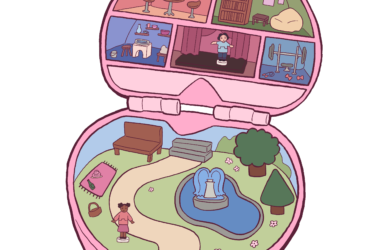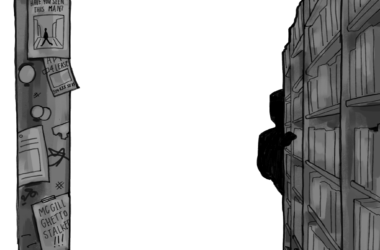When Martlet Lacrosse captain Megan Halbrook went to the McGill Varsity Athletics website last May and found her team’s webpage missing, she had no idea what it signified.
“I called the web page administrator in Athletics because I assumed something had gone wrong in the computer code,” Halbrook says. “She informed me that because we weren’t a varsity team we weren’t allowed to have a page under varsity sports. And that’s how I found out we weren’t a varsity team anymore.”
This change in status for the Martlets was part of a major restructuring of McGill’s varsity teams system implemented at the start of this school year. Prior to these changes, McGill operated on a three-tier system. Level I teams consisted of football, hockey, basketball, soccer, swimming, and women’s volleyball, while Level II included cross country, track, rugby, badminton, rowing, and men’s volleyball. Level III teams, also known as intercollegiate clubs, included all other teams.
Under the new system, Level I teams operate under the status quo. While men’s volleyball was removed from Level II, a number of teams have been added in addition to the previously mentioned teams: baseball, women’s field hockey, men’s lacrosse, alpine ski, and synchronized swimming. Men’s volleyball was removed from Level II.
The biggest changes, however, were aimed at the Level III teams. These teams, now comprised of cheerleading, cricket, curling, cycling, fencing, figure skating, women’s lacrosse, nordic ski, squash, tennis, ultimate, and men’s volleyball, are no longer considered “teams” by the university. Instead, they are now called “competitive clubs,” and fall under the purview of campus recreation. Because members are no longer considered varsity athletes, they can no longer use the varsity gym. These teams no longer receive funding from Athletics and must instead pay the administration an annual fee of $100 per team. They are also not permitted to compete in CIS, OUA, or QSSF leagues or competitions.
According to Athletics Director Drew Love, this restructuring was partially the result of budget considerations. Facing shortfalls in some program expenditures, McGill Athletics cut approximately $120,000 from intercollegiate sports. Love emphasized, however, that these changes were also the result of a major review of all Athletics programs and sports which the department conducts every four to five years.
“When you look at how you deliver your programming you also have to look at what’s happening at other schools across the country, at our leagues, and what we have available to deliver,” he says. “Queen’s has made similar moves as we’ve done.”
For the 30 members of the McGill ultimate team, the team fee is not a major issue, according to its president Rumi Tejpar. However, the loss of varsity status has a significant impact.
“It’s a heavy commitment, and to not be able to say that you play on a varsity team, that you’re just a club, means you have very little credibility,” he says. “People won’t choose to come to McGill now if they can’t say they’re a varsity athlete.”
Halbrook says that while losing varsity status was disappointing, the main challenge the Martlets have faced has to do with medical services. Now, Halbrook says, simply obtaining a roll of medical tape is a five-step process.
“If someone needs their ankle taped, I do it,” she says. “The only experience I have is from watching YouTube videos.”
Tom Fabian, Students’ Society vice-president internal, former Varsity Council president and men’s volleyball team member, says that while he understands the restructuring from a sports management perspective, he’s concerned with the lack of transparency behind the decision-making process.
“The main issue for a lot of athletes is that there was no real criteria for us to see,” he says. “I understand why they did it, but it wasn’t a fair process.”
Both Halbrook and Love acknowledged that the OUA’s prior restructuring to eliminate its women’s lacrosse, squash, tennis, and figure skating leagues impacted these teams’ position in McGill’s new system. With the OUA’s decision, these McGill teams lost leagues in which to compete. However, Halbrook says when she approached the Athletics administration with questions, they were unresponsive.
“The varsity people told me I wasn’t under their jurisdiction, and the recreation admin said they didn’t know what to do with us,” she says. “I wrote long, impassioned emails to Drew Love and Lisen Moore and they responded by sending me a PowerPoint presentation.”
Although there is no longer an OUA women’s lacrosse league, the team competed through the Fall in a private league organized by Halbrook and the coaches of the teams that previously played in the league. While the OUA is sponsoring a women’s lacrosse championship, the Martlets cannot attend due to a McGill regulation which stipulates that teams who are not part of officially sanctioned leagues cannot compete in championships.
“To not let us go to championships is like cutting us at our knees,” Halbrook says. “I just want to hold the trophy and now that’s not possible.”
The situation of the men’s volleyball team, however, is unique in that it is the only team to be dropped to competitive club level that could still possibly compete in a sanctioned league, in their case the CIS. According to Love, when compared to universities across the country, McGill had been drastically underfunding the men’s volleyball team. Athletics was thus faced with the option of either investing at least $100,000 in the program or cutting it completely.
“It couldn’t continue the way it was. Its competitiveness was not there. The continuity of the program without a full-time coach was not there. We didn’t offer financial assistance to our athletes so we were unable to recruit the best student athletes,” Love says. “They were taking a significant amount of funding for what they were doing, and we felt that it was best for those funds to be redistributed.”
Ryan Brant, assistant coach and former men’s volleyball player, however, disagreed with Love regarding the team’s competitiveness.
“If everything stayed the same, our team would have fought for second or third place in our league this year. We had very strong returning players,” he says. “We just weren’t given an opportunity to continue to play.”
He was also confident that the team would find a way to finance many of their expenses, even with no support from McGill.
“We could have fundraised. I would have coached for free,” Brant says. “When we met with Lisen Moore, the intercollegiate manager, we asked what we could do to save our program, and she said we needed to raise $2 million. We thought we could raise $30,000, but they were concerned about a lack of funding year to year.”
Like Halbrook, Martlet lacrosse Head Coach Heather Roffey and members of the men’s volleyball team were disappointed with how and when news of the restructuring was conveyed to them.
“I hold no animosity towards the department if changes needed to be made to create stronger athletic programs,” Roffey says. “Being a part of the decision process, or having some advanced warning of decisions already made, would have lessened the emotional impact.”
While Halbrook learned of the change through the McGill website, Fabian says his team’s coach was informed over the phone in late April.
“It was pretty awful that they didn’t tell us, when we asked them so many times,” Fabian says. “It wasn’t until the day after the Athletics Gala that they even told the coaches.”
Love, however, said that restructuring announcements are always made once all teams have completed their seasons.
“The reality is there’s no good time to make an announcement,” he says. “If you make announcements prior to the end of the season that a team is no longer going to compete after the season, now you have an emotional environment where you have people participating on a team that isn’t going to exist any longer.”
When they learned of the change, two freshman volleyball players decided to transfer to Ontario schools that still offered volleyball teams. In addition, Brant had to inform their numerous recruits that the team would no longer exist. While some decided to attend McGill regardless, others opted to go elsewhere—in Dominic Kucharski’s case, the University of Montreal.
“I applied [to McGill] because it’s such a great school academically, and combined with volleyball, it would have been the perfect school for me,” he says. “As much as I wanted to go to McGill, I wanted to play volleyball as well, so I had to look at other options.”
Kucharski said that while he is happy to be playing volleyball, he is still disappointed.
“I was devastated when I found out. I felt like all my future plans were gone out the window,” he says. “I knew what rez I would be in, I knew some of the guys on the team. I was really looking forward to playing for McGill.”
For former Level III teams, however, McGill’s new sports model has provided increased support and recognition. Love cited the men’s baseball team, who recently won the National Championship, as an example of the possible success of such a system. Synchronized swimming Head Coach Cassandra Bilogan said the increase in pool time her team received this year is just as significant as any financial support.
“It’s frustrating having minimal pool time and having one of the only teams at McGill that consistently wins nationals and places well at all their competitions,” she says. “I’ve been fighting for this for years, and this is the first year we actually got more time and it’s been really helpful.”
In addition to increased support for new Level II teams, Love explained that the department has hired a part-time clubs coordinator whose main task is to offer support and guidance to the competitive clubs. Roffey said the support structure in place has been particularly beneficial for her team.
“I think it is important to note that the newly formed sport club office has been extremely understanding, helpful, and patient with our team as we navigate through this season,” she says. “They are working with the teams to create competitive programs with the fewer resources we now have.”
According to Norman O’Reilly, associate professor of sport business at the University of Ottawa, a lack of resources has become an issue for university athletic departments across Canada. O’Reilly agreed with Fabian and Love that such a system of prioritizing certain teams is becoming a common response to financial issues among Canadian schools.
“The bottom line is athletics departments without exception are cost cutters for universities,” he says. “They’re not revenue generators.”
According to O’Reilly, different Canadian universities have implemented various models in response to the funding cuts that began about a decade ago. Some schools have chosen to prioritize and promote one specific team—for example, Laval’s football program or Carleton’s powerhouse men’s basketball team. O’Reilly explained that these teams are now revenue generators for their respective schools, with money being invested into other teams and facilities. Other schools, including Nippissing and Lakehead, have moved to mixed funding for some teams. Under this model, the men’s hockey teams are underwritten by a group of alumni.
With regard to McGill, however, O’Reilly explained that while teams representing less prominent sports can often support themselves financially, they often need official recognition from the university in order to survive.
“If you accept your reality then you can figure out a way to make your resources work,” he says. “But in order to be able to do that, you have to be able to maintain your varsity status. With a tiered system where teams actually lose their varsity status, you’re basically killing them. They’ll be a club for a while, then it will eventually peter off.”
Tejpar echoed a similar sentiment.
“I understand that McGill doesn’t have that much money. But varsity status doesn’t cost them any money,” he says. “It’s a glorified intramural, and that’s not what we are. We are a varsity team.”
Love says he is confident the restructuring has been beneficial since it has clarified the roles of varsity and club teams, and added that similar reviews will continue in the future.
“This has set us up for the next four years or so in a way that lines consistent with what other universities are doing and what the sport system is doing in Canada with respect to university sport,” he says.
Roffey is hopeful that the Martlets will regain varsity status, but also emphasized that her team is still moving forward regardless.
“Fancy practice uniforms and unlimited access to trainers are a benefit, but they do not change the heart of a player,” she says. “My players have heart. That is why we still have a team.”
Brant, however, was not as optimistic.
“All the effort we put in to build this team up now means nothing. I felt like we were leaving a dynasty,” he says. “I gave 30 or 40 hours a week for four years, for nothing. My dream was to coach this team someday. And now it’s gone.”








